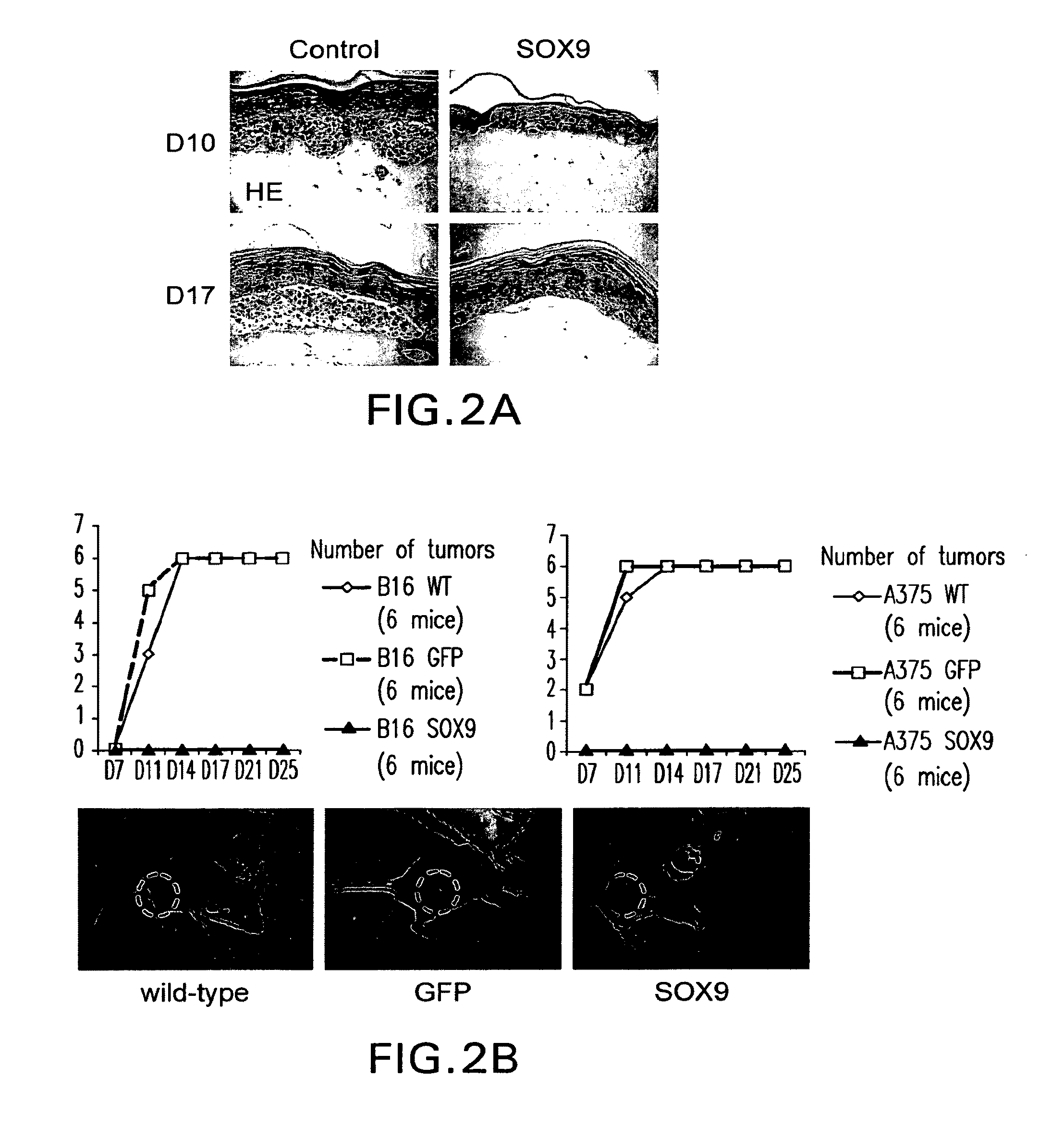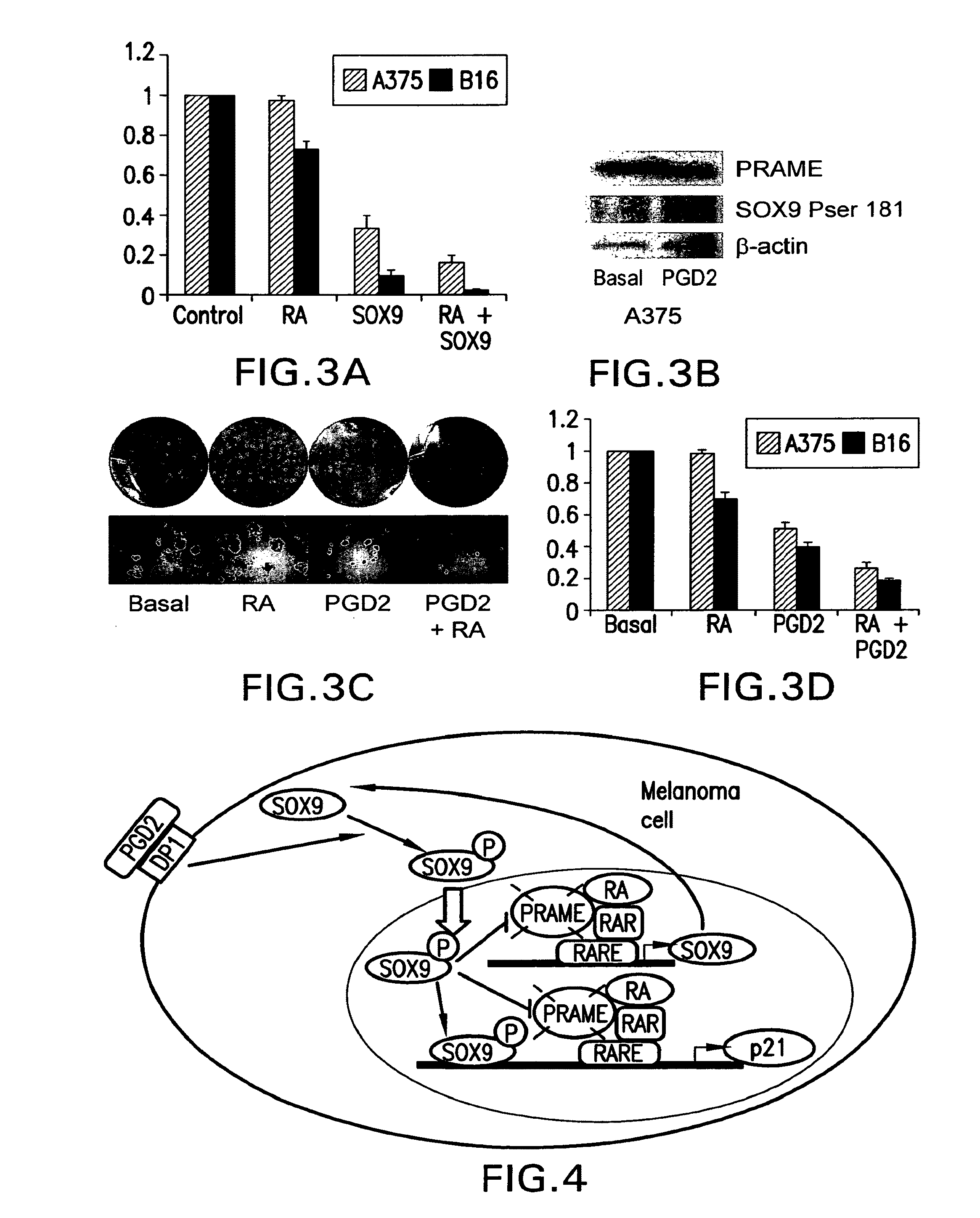Compositions and methods for treating pigmentary conditions and melanoma
a technology for pigmentary conditions and compositions, applied in the field of compositions and methods for treating pigmentary conditions and melanoma, can solve the problems of reducing the quality of life of individuals affected by vitiligo, no treatment is truly satisfactory, and psychological discomfor
- Summary
- Abstract
- Description
- Claims
- Application Information
AI Technical Summary
Problems solved by technology
Method used
Image
Examples
example 1
SOX9 Inhibits Proliferation of Melanoma Cell Lines
[0190]In this study the expression and the role of SOX9 in melanoma was investigated. SOX9 strongly regulates the proliferation of melanoma cell lines. It blocks cell progression from phase G1 to S through a direct and indirect regulation of the p21 promoter. Over-expression of SOX9 prevents tumorigenicity of melanoma cells both in mice and in an ex vivo human model. Studying the relative expression of SOX9 and p21 in nearly 40 melanoma samples showed that SOX9 is down-regulated in the majority of patients but that in two patients some clones expressed high levels of SOX9 concordantly with an increased expression of p21. SOX9 also promotes the differentiation of melanoma cells and decreases expression of the melanoma antigen PRAME. Through the down-regulation of PRAME, the over-expression of SOX9 restores the sensitivity of melanoma to RA leading to a strong synergistic effect when SOX9 and RA are combined. The present results show t...
example 2
SOX9 is Expressed in Melanocytes and has a Role in UVB-Induced Melanocyte Differentiation and Pigmentation
[0213]SOX9 is expressed in vitro and in vivo in normal melanocytes and regulates UVB induced pigmentation through a direct activation of the MITF promoter. SOX9 directly regulates MITF, one of the master genes for melanogenesis, which has also been demonstrated to regulate melanocyte and melanoma cell proliferation.
Materials and Methods
Reagents, Cell Lines, and Culture Conditions.
[0214]Neonatal and adult human foreskin melanocytes (a-LP, n-LP, n-MP and n-DP) were obtained from Cascade Biologics, Inc (Portland, Oreg., USA). B16 / F10 melanoma cells and HeLa cells were obtained from the ATCC (Manassas, Va., USA). Cultured melanocytes were grown in melanocyte growth medium consisting of Medium 254 and HMGS (both from Cascade Biologics, Inc). Melanocytes from the third to ninth passage were used in these experiments. B16 cells were grown at 37° C. under 5% CO2 in DMEM supplemented wit...
example 3
Mice Over-Expressing SOX9 are Protected Against Melanoma
[0241]As shown herein, over-expression of Sox9 in human and mouse melanoma cells strongly decreased their proliferation in cell culture. This study confirms that the decrease of the proliferation rate of cancer cell lines reflects a decrease in its tumorigenicity in vivo. Stable transfection in mouse and human melanoma cells has been established above. Here, mouse melanoma B16 / F10 cells are injected into C57B16 mice while human melanoma A375 cells are injected into nude mice. A comparison of wild-type to transfected cells can be made.
[0242]The first stage comprises injecting (a) 1×10{6} B16 / F10 cells transfected with lentivirus over-expressing Sox9 (total 200 μl) or (b) 1×10{6} B16 / F10 cells transfected with lentivirus control into right flank of each C57B16 mouse, SC, needle size 26G1 / 2. Total 20 mice. Then, 1×10{6} A375 cells transfected with lentivirus over-expressing Sox9 (total 200 μl) or 1×10{6} A375 cells transfected wit...
PUM
| Property | Measurement | Unit |
|---|---|---|
| diameter | aaaaa | aaaaa |
| pH | aaaaa | aaaaa |
| temperature | aaaaa | aaaaa |
Abstract
Description
Claims
Application Information
 Login to View More
Login to View More - R&D
- Intellectual Property
- Life Sciences
- Materials
- Tech Scout
- Unparalleled Data Quality
- Higher Quality Content
- 60% Fewer Hallucinations
Browse by: Latest US Patents, China's latest patents, Technical Efficacy Thesaurus, Application Domain, Technology Topic, Popular Technical Reports.
© 2025 PatSnap. All rights reserved.Legal|Privacy policy|Modern Slavery Act Transparency Statement|Sitemap|About US| Contact US: help@patsnap.com



